The vibrant versatility of carrots
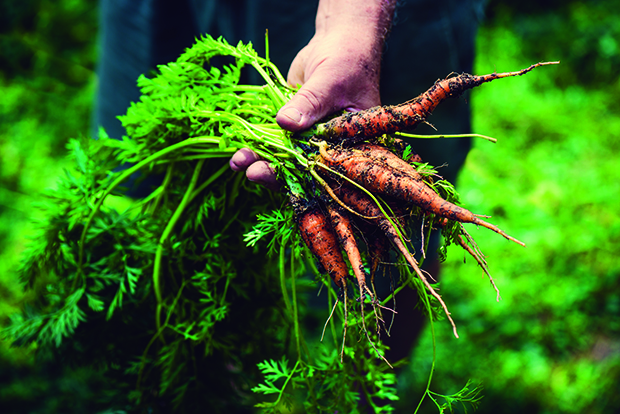
There’s not much you can’t do with this beloved orange vegetable.
Words: Jenny Garing
There are many things that come to mind when people think of the colour orange. Carrots are usually near the top of the list. Shocking, then, to discover that carrots weren’t always this colour. For the thousands of years since they were first cultivated and foraged, carrots were red, purple, black, yellow, and white varietals. They were thought to have been hybridised to the bright orange colour we know today in 16th century Holland. One theory suggests this was done to celebrate the Dutch Royal Family – the House of Orange. In any case, orange carrots have since spread around the world to become some of the most widely-consumed vegetables. With plenty of fibre, three times the daily dose of vitamin A in one serving, and virtually endless culinary uses, it’s no wonder they’ve become so popular. They contain alpha-carotene, which has been shown to reduce cancer risk and improve eyesight. They also contain good levels of falcarinol, polyphenols, copper and calcium. The healthy components of the carrot are located mostly just under the skin, so don’t peel your carrots as this would discard these wonderful polyphenols. Instead, just give them a good wash before cooking or eating.
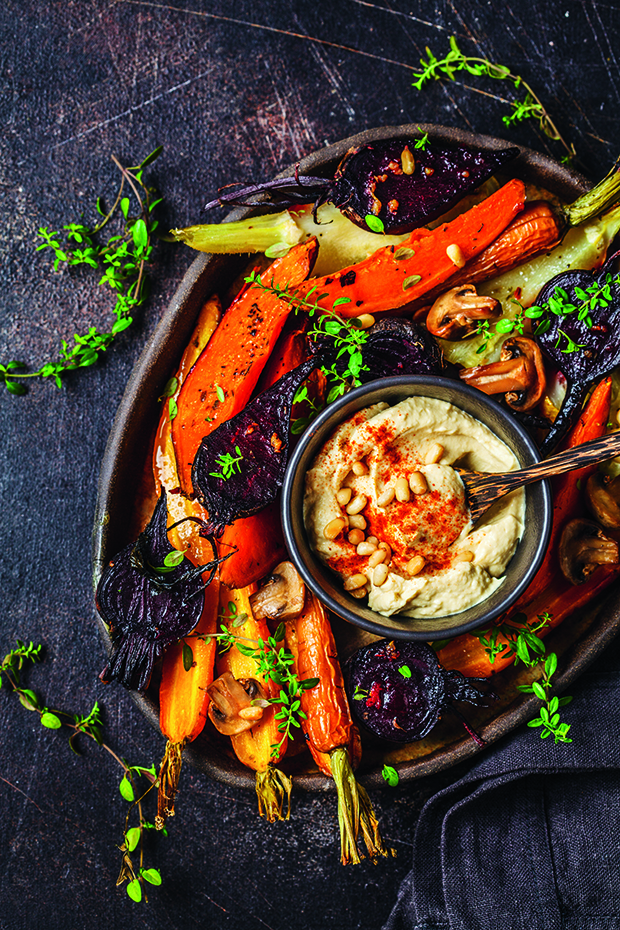
Roasted carrots with hummus.
Carrots are exceptionally versatile and can be eaten steamed, baked, confit, grilled, pureed or grated. They can be juiced, turned into fritters or tempura or made into cakes or muffins. The sweetness and earthiness of carrots means they team up well with ginger, garlic, orange, honey, tahini, sesame seeds, peanuts, walnuts, cumin, nutmeg, cinnamon and cardamom. They love parsley, dill and fresh coriander and can handle being cooked with sherry and red wine.
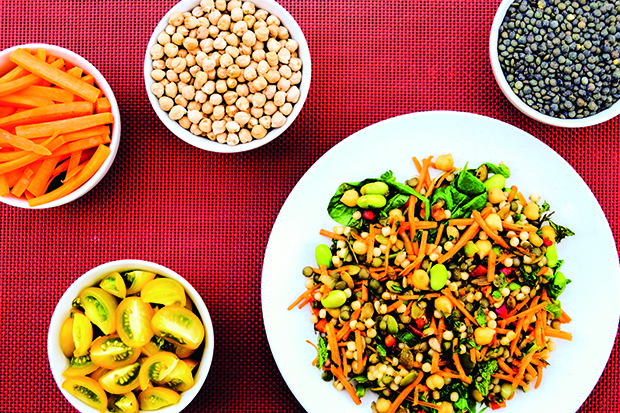
Summer salad – Israeli couscous, edamame beans, greens and carrots.
Many cultures use carrots in salad. A traditional Tunisian carrot salad called Omok Houria (Mother Fairy) has steamed carrots that are coarsely mashed and then mixed with red harissa, capers, garlic and lemon. It’s spread on a platter and topped with olives, hard-boiled eggs and maybe some canned tuna. Another nutritious and tasty option is to cut carrots into batons and boil or bake, and then combine with cooked bulgur wheat, freekeh or Israeli couscous and lots of herbs and lemon juice. It can be enriched with toasted almonds or walnuts and other vegetables. For a simple option, try using your potato peeler to slice long ribbons of carrot, marinate them in olive oil and orange juice, then serve with fresh coriander, whipped feta, cinnamon and chilli flakes.
BABY CARROTS
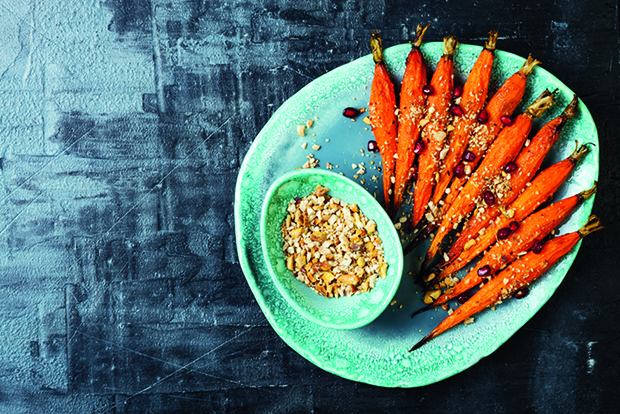
Baby Carrots with Dukkah.
Baby or spring carrots are great as crudites for dips but they also look fantastic cooked whole, especially if you have a mix of colours. You can roast them in a little oil and lemon juice and then serve them topped with a sprinkling of dukkah or chopped nuts. Or try confit baby carrots over-baked in lots of olive oil at 150˚C in a tightly covered roasting pan for about two hours. They come out silky and sweet. For extra flavour, you can add fennel, cumin, coriander seeds or whole garlic cloves to the roasting pan while cooking.
Jenny’s Favourite Carrot Salad
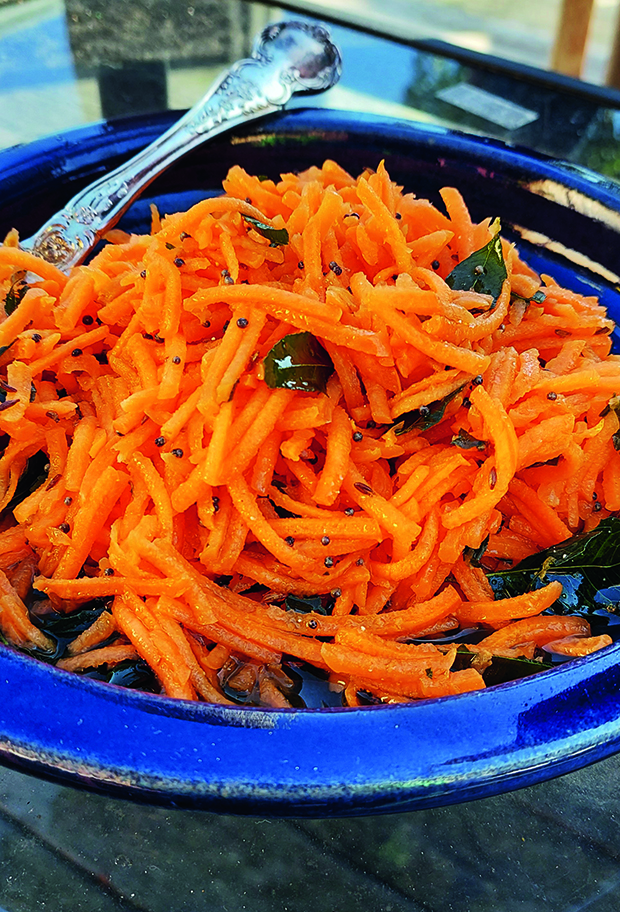
Prep time: 5 minutes
Cook time: 3 minutes
Serves: 4-6
This recipe is originally from Karnataka in India, but can be served alongside western dishes. I have used this dish to convert people who think carrot salad is boring. The tempering of the spices in the oil is essential and the hot oil needs to be added to the cold carrot just before serving. You can buy fresh curry leaves in season at the supermarket, or use dried ones.
INGREDIENTS
3 large carrots
juice from 1-2 limes
¾ tsp salt
3 tbsp oil (I use rice bran)
¼ tsp black mustard seeds
1 tsp cumin seeds
8-10 curry leaves
½ tsp asafoetida (hing)
METHOD
Grate the carrots (in a food processor is easiest) and put in a bowl with the juice of the limes and the salt. Heat the oil in a small saucepan. When it’s hot, add the mustard and cumin seeds.
When the mustard seeds start to pop, add the curry leaves and asafoetida. Swirl around and then pour over the carrots. Mix it in quickly, taste for seasoning and serve.
Love this story? Subscribe now!
 This article first appeared in NZ Lifestyle Block Magazine.
This article first appeared in NZ Lifestyle Block Magazine.

